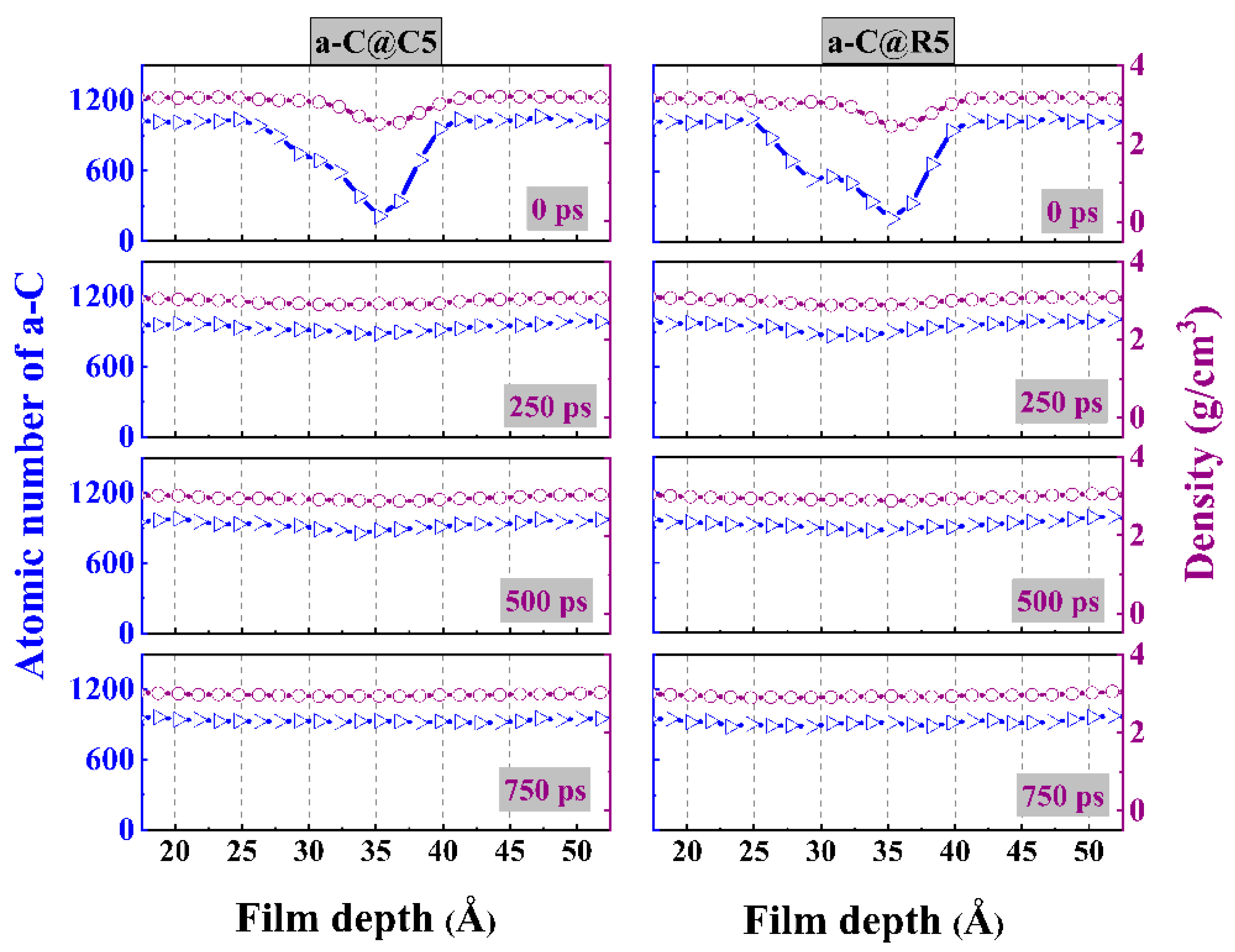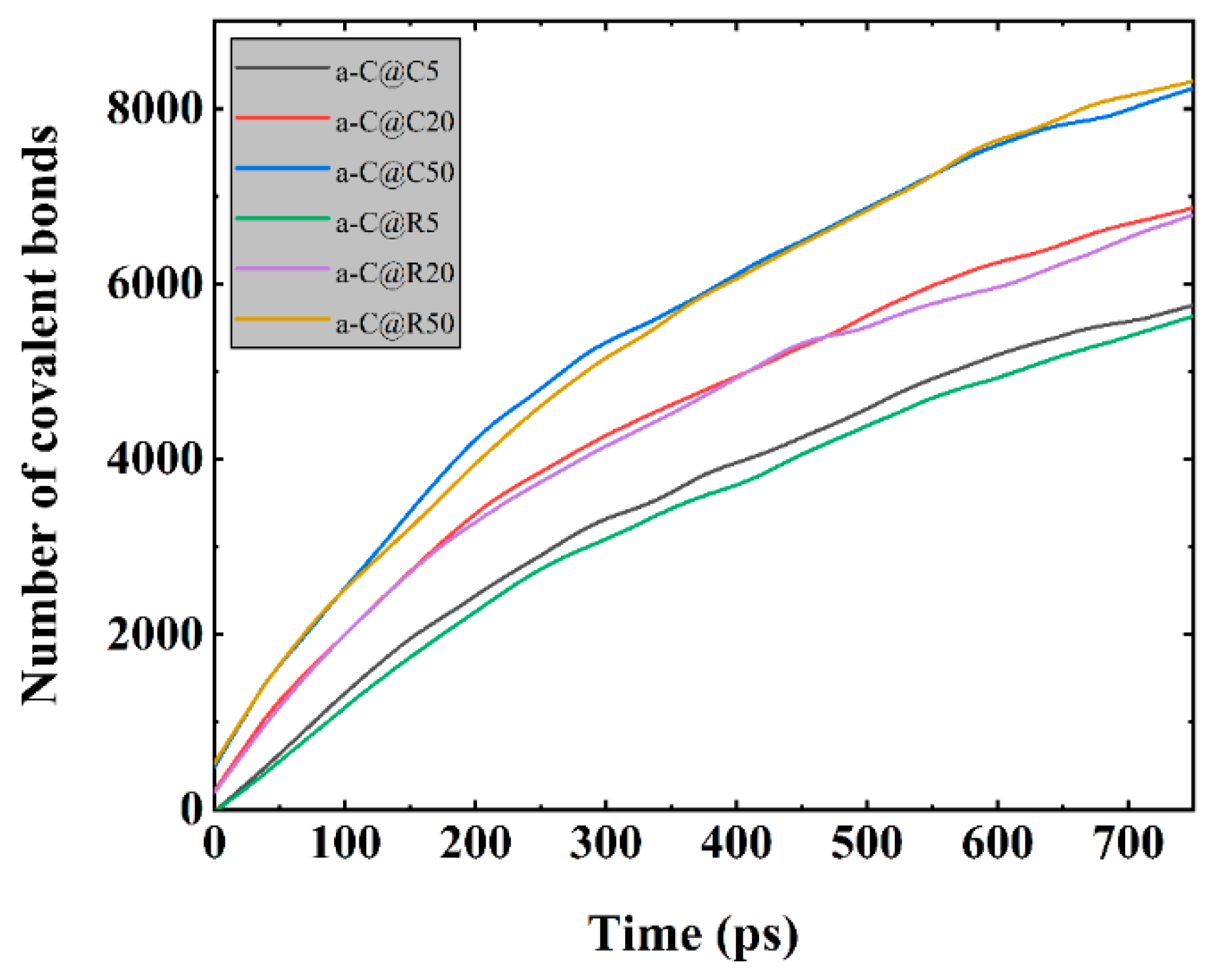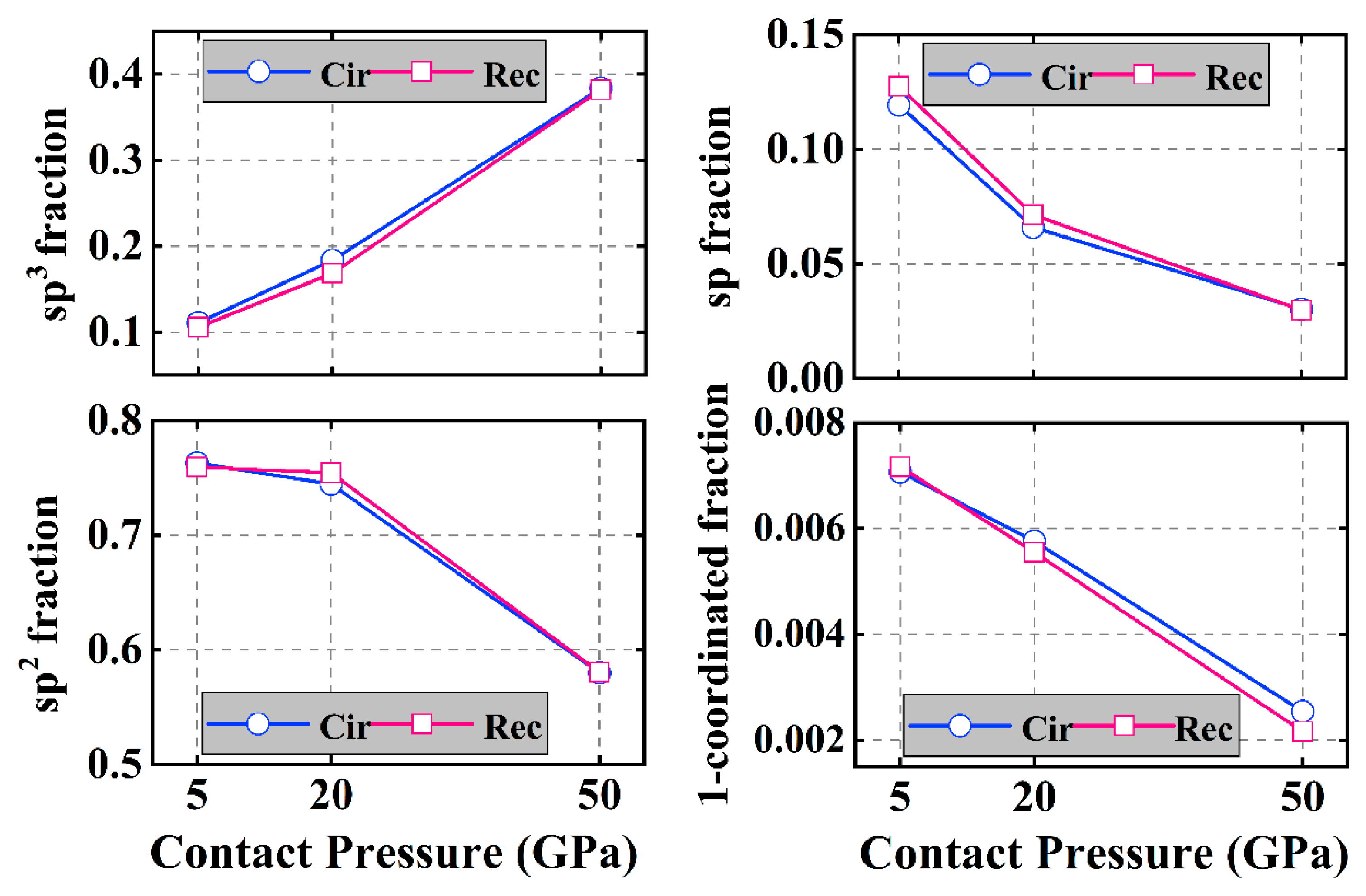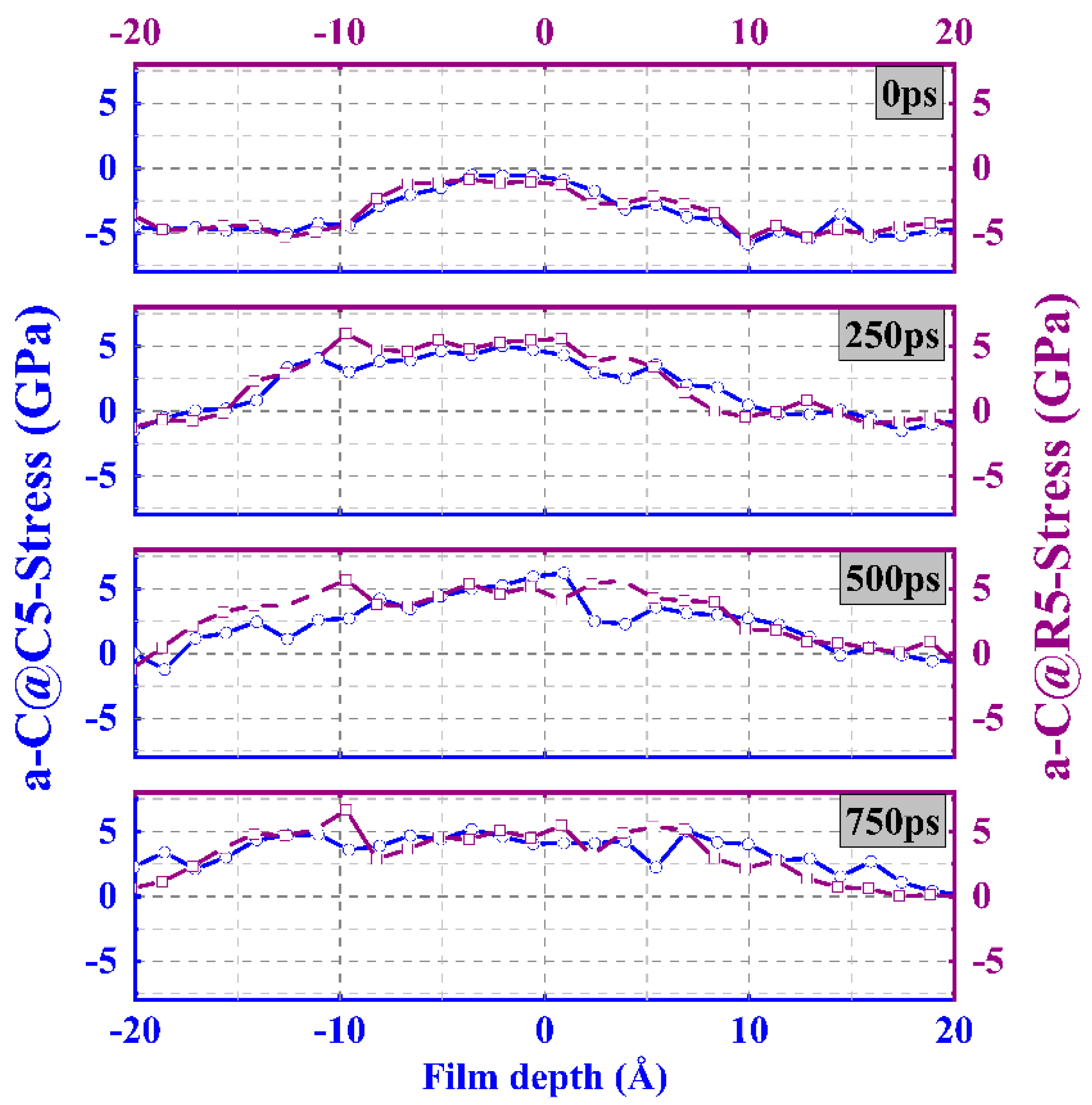Atomic-Scale Understanding on the Tribological Behavior of Amorphous Carbon Films under Different Contact Pressures and Surface Textured Shapes
Abstract
:1. Introduction
2. Methods
3. Results and Discussion
4. Conclusions
- The tribological properties of a-C films were sensitive to the textured shape under low contact pressure, and the tribological properties of the circular textured system were better than those of the rectangular textured system. This was due to the higher fraction of the sp3 hybridized structure and smaller unsaturated bond fractions at the friction interface.
- When increasing the contact pressure from 5 to 50 GPa, on the one hand, the stress at the friction interface changed from a tensile to compressive state following the significant sp-to-sp3 and sp2-to-sp3 transformation. This not only induced the passivation of the friction interface, but also decreased the content of dangling bonds in an obvious manner, which led to the growth rate of friction forces being slower than that of the normal load, accounting for the significant decrease in the friction coefficient with contact pressure. However, on the other hand, under such high contact pressure, these two textured systems exhibited similar changes in the interfacial structure, including the hybridized structure and the interfacial stress, so no obvious difference in the friction coefficient was observed. These findings contribute to the in-depth investigation of the friction mechanism of textured a-C films, and, most importantly, they can guide scientific and technical applications for the creation of innovative and effective carbon-based lubrication systems.
Supplementary Materials
Author Contributions
Funding
Institutional Review Board Statement
Informed Consent Statement
Data Availability Statement
Conflicts of Interest
References
- Williams, J.A.; Le, H.R. Tribology and MEMS. J. Phys. D Appl. Phys. 2006, 39, R201–R214. [Google Scholar] [CrossRef]
- Dai, W.; Liu, F.; Ding, J.C.; Wang, Q.M.; Kwon, S.H. Amorphous carbon films with MoCu dual-doping deposited by a hybrid sputtering system. Diam. Relat. Mater. 2018, 87, 107–114. [Google Scholar] [CrossRef]
- Robertson, J. Diamond-like amorphous carbon. Mater. Sci. Eng. R Rep. 2002, 37, 129–281. [Google Scholar] [CrossRef]
- Martinez-Martinez, D.; van der Pal, J.P.; Schenkel, M.; Shaha, K.P.; Pei, Y.T.; De Hosson, J.T.M. On the nature of the coefficient of friction of diamond-like carbon films deposited on rubber. J. Appl. Phys. 2012, 111, 114902. [Google Scholar] [CrossRef]
- Erdemir, A.; Donnet, C. Tribology of diamond-like carbon films: Recent progress and future prospects. J. Phys. D Appl. Phys. 2006, 39, R311–R327. [Google Scholar] [CrossRef]
- Tyagi, A.; Walia, R.S.; Murtaza, Q.; Pandey, S.M.; Tyagi, P.K.; Bajaj, B. A critical review of diamond like carbon coating for wear resistance applications. Int. J. Refract. Met. Hard Mater. 2019, 78, 107–122. [Google Scholar] [CrossRef]
- Bewilogua, K.; Hofmann, D. History of diamond-like carbon films—From first experiments to worldwide applications. Surf. Face Coat. Technol. 2014, 242, 214–225. [Google Scholar] [CrossRef]
- Vetter, J. 60 years of DLC coatings: Historical highlights and technical review of cathodic arc processes to synthesize various DLC types, and their evolution for industrial applications. Surf. Coat. Technol. 2014, 257, 213–240. [Google Scholar] [CrossRef]
- Li, X.W.; Wang, A.Y.; Lee, K.R. Atomistic understanding on friction behavior of amorphous carbon films induced by surface hydrogenated modification. Tribol. Int. 2019, 136, 446–454. [Google Scholar] [CrossRef]
- Wei, P.; He, M.Y.; Ao, W.B. Molecular dynamics study of the frictional behaviors of diamond-like carbon films. Appl. Phys. ICS A Mater. Sci. Process. 2021, 127, 652. [Google Scholar] [CrossRef]
- Wang, L.P.; Bai, L.C.; Lu, Z.B.; Zhang, G.A.; Wu, Z.G. Influence of Load on the Tribological Behavior of a-C Films: Experiment and Calculation Coupling. Tribol. Lett. 2013, 52, 469–475. [Google Scholar] [CrossRef]
- Rosenkranz, A.; Costa, H.L.; Baykara, M.Z.; Martini, A. Synergetic effects of surface texturing and solid lubricants to tailor friction and wear—A review. Tribol. Int. 2021, 155, 106792. [Google Scholar] [CrossRef]
- Rosenkranz, A.; Grutzmacher, P.G.; Gachot, C.; Costa, H.L. Surface Texturing in Machine Elements—A Critical Discussion for Rolling and Sliding Contacts. Adv. Eng. Mater. 2019, 21, 1900194. [Google Scholar] [CrossRef]
- Gropper, D.; Wang, L.; Harvey, T.J. Hydrodynamic lubrication of textured surfaces: A review of modeling techniques and key findings. Tribol. Int. 2016, 94, 509–529. [Google Scholar] [CrossRef]
- Du, N.Z.; Feng, C.A.; Chen, K.; Qiao, J.H.; Zhang, D.K.; Li, X.W. Friction dependence on the textured structure of an amorphous carbon surface: A reactive molecular dynamics study. Appl. Surf. Sci. 2023, 610, 155584. [Google Scholar] [CrossRef]
- Arslan, A.; Masjuki, H.H.; Varman, M.; Kalam, M.A.; Quazi, M.M.; Al Mahmud, K.A.H.; Gulzar, M.; Habibullah, M. Effects of texture diameter and depth on the tribological performance of DLC coating under lubricated sliding condition. Appl. Surf. Sci. 2015, 356, 1135–1149. [Google Scholar] [CrossRef]
- de Almeida, E.A.D.; Milan, J.C.G.; da Costa, C.E.; Binder, C.; de Mello, J.D.B.; Costa, H.L. Combined Use of Surface Texturing, Plasma Nitriding and DLC Coating on Tool Steel. Coatings 2021, 11, 201. [Google Scholar] [CrossRef]
- Wang, Y.; Yamada, N.; Xu, J.X.; Zhang, J.; Chen, Q.; Ootani, Y.; Higuchi, Y.; Ozawa, N.; Bouchet, M.I.D.; Martin, J.M.; et al. Triboemission of hydrocarbon molecules from diamond-like carbon friction interface induces atomic-scale wear. Sci. Adv. 2019, 5, eaax9301. [Google Scholar] [CrossRef] [PubMed]
- Plimpton, S. Fast Parallel Algorithms for Short-Range Molecular Dynamics. J. Comput. Phys. 1995, 117, 1–19. [Google Scholar] [CrossRef]
- Ma, T.B.; Hu, Y.Z.; Wang, H.; Li, X. Microstructural and stress properties of ultrathin diamond-like carbon films during growth: Molecular dynamics simulations. Phys. Rev. B 2007, 75, 035425. [Google Scholar] [CrossRef]
- Shi, L.; Zhang, Z.H.; Liao, M.D.; Zhou, C.Y.; Sun, C.F. The tribology behaviors of textured graphite-like carbon film under air and aqueous environments. Surf. Topogr. Metrol. Prop. 2019, 7, 044004. [Google Scholar] [CrossRef]
- Ferrari, A.C. Diamond-like carbon for magnetic storage disks. Surf. Coat. Technol. 2004, 180, 190–206. [Google Scholar] [CrossRef]
- Zhang, Y.F.; Polychronopoulou, K.; Humood, M.; Polycarpou, A.A. High temperature nanotribology of ultra-thin hydrogenated amorphous carbon coatings. Carbon 2017, 123, 112–121. [Google Scholar] [CrossRef]
- Tavazza, F.; Senftle, T.P.; Zou, C.; Becker, C.A.; van Duin, A.C.T. Molecular Dynamics Investigation of the Effects of Tip-Substrate Interactions during Nanoindentation. J. Phys. Chem. C 2015, 119, 13580–13589. [Google Scholar] [CrossRef]
- Ma, T.B.; Wang, L.F.; Hu, Y.Z.; Li, X.; Wang, H. A shear localization mechanism for lubricity of amorphous carbon materials. Sci. Rep. 2014, 4, 3662. [Google Scholar] [CrossRef]
- Bai, S.D.; Onodera, T.; Nagumo, R.; Miura, R.; Suzuki, A.; Tsuboi, H.; Hatakeyama, N.; Takaba, H.; Kubo, M.; Miyamoto, A. Friction Reduction Mechanism of Hydrogen- and Fluorine-Terminated Diamond-Like Carbon Films Investigated by Molecular Dynamics and Quantum Chemical Calculation. J. Phys. Chem. C 2012, 116, 12559–12565. [Google Scholar] [CrossRef]
- Bundy, F.P. Pressure-temperature phase diagram of elemental carbon. Physic A Stat. Mech. Its Appl. 1989, 156, 169–178. [Google Scholar] [CrossRef]
- Ma, T.-B.; Hu, Y.-Z.; Wang, H. Molecular dynamics simulation of shear-induced graphitization of amorphous carbon films. Carbon 2009, 47, 1953–1957. [Google Scholar] [CrossRef]








Disclaimer/Publisher’s Note: The statements, opinions and data contained in all publications are solely those of the individual author(s) and contributor(s) and not of MDPI and/or the editor(s). MDPI and/or the editor(s) disclaim responsibility for any injury to people or property resulting from any ideas, methods, instructions or products referred to in the content. |
© 2023 by the authors. Licensee MDPI, Basel, Switzerland. This article is an open access article distributed under the terms and conditions of the Creative Commons Attribution (CC BY) license (https://creativecommons.org/licenses/by/4.0/).
Share and Cite
Chen, Z.; Du, N.; Li, X.; Wei, X.; Ding, J.; Lu, S.; Du, S.; Feng, C.; Chen, K.; Zhang, D.; et al. Atomic-Scale Understanding on the Tribological Behavior of Amorphous Carbon Films under Different Contact Pressures and Surface Textured Shapes. Materials 2023, 16, 6108. https://doi.org/10.3390/ma16186108
Chen Z, Du N, Li X, Wei X, Ding J, Lu S, Du S, Feng C, Chen K, Zhang D, et al. Atomic-Scale Understanding on the Tribological Behavior of Amorphous Carbon Films under Different Contact Pressures and Surface Textured Shapes. Materials. 2023; 16(18):6108. https://doi.org/10.3390/ma16186108
Chicago/Turabian StyleChen, Zan, Naizhou Du, Xiaowei Li, Xubing Wei, Jiaqing Ding, Shiqi Lu, Shuangjiang Du, Cunao Feng, Kai Chen, Dekun Zhang, and et al. 2023. "Atomic-Scale Understanding on the Tribological Behavior of Amorphous Carbon Films under Different Contact Pressures and Surface Textured Shapes" Materials 16, no. 18: 6108. https://doi.org/10.3390/ma16186108




